PDF chapter test TRY NOW
Forests are home to around 300 million trees worldwide, and 1.6 billion people depend on them for their livelihood. And apart from that, forests provide food and shelter to a diverse range of living species.
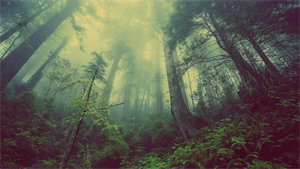
Evergreen forest
Living organisms which live in or near forests or near hills could never imagine what a desert would be like. In a desert, the amount of evaporation exceeds the amount of annual rainfall.
Most people think of a desert to be a vast expanse of land unfit for any living being to survive. It is a common misconception that a desert is entirely made up of sand and is unsuitable for plant growth.
Most people think of a desert to be a vast expanse of land unfit for any living being to survive. It is a common misconception that a desert is entirely made up of sand and is unsuitable for plant growth.
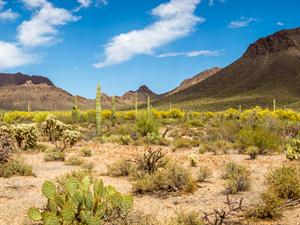
Desert landscape
Desert rainfall is one of the primary reason in determining the desert condition. A desert, according to scientists, averages not more than \(25\) centimetres (\(10\) inches) of precipitation per year.
For many people, the desert seems to be a region of hotness and dryness. They assume that no one can live there. Such beliefs about the desert were pure assumptions, without any exact fact.
While it may be true that grass, plants, and trees did not always cover a desert region, unlike other climatic areas, desert flowers also bloom for sure if it rains. However, it often doesn't occur, and the sight can be as enjoyable as that of a tropical landscape.
For many people, the desert seems to be a region of hotness and dryness. They assume that no one can live there. Such beliefs about the desert were pure assumptions, without any exact fact.
While it may be true that grass, plants, and trees did not always cover a desert region, unlike other climatic areas, desert flowers also bloom for sure if it rains. However, it often doesn't occur, and the sight can be as enjoyable as that of a tropical landscape.
As some people think, deserts are not always barren place filled with dry sand that would be unfit for any living organism to live. Instead, some deserts contain natural features like mountains and strange shaped hills and rocks.
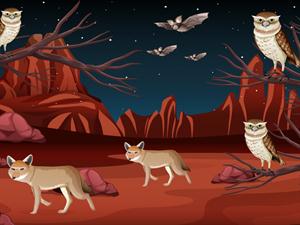
Desert rocks, mountains and animals
Living organisms could live a life in a desert if they can adapt to the hot climate. It's not true that a desert would be hot always. Leading a life is in deserts are possible for living organisms that can adapt to the harsh situations of the desert.
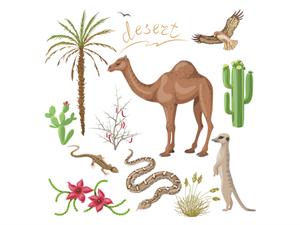
Desert plants and animals
Deserts will not always remain hot; it would be cold during the night as there is little water vapour in the air to trap the heat from the daytime; deserts are hot as there is no water, desert directly absorbs sunlight.
Deserts will not always remain hot; it would be cold during the night as there is little water vapour in the air to trap the heat from the daytime; deserts are hot as there is no water, desert directly absorbs sunlight.
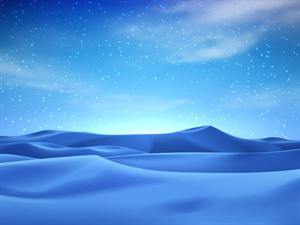
Desert landscape during night
Most of the deserts do have water resources in them. The location where water and human survival coexist in a desert is called an 'oasis.' An oasis can be large or small. An oasis is a water-rich region amidst a desert where springs or a well provide more opportunities for plants and trees to grow. It's a fertile region where the water table approaches the surface. This oasis supports vegetation.
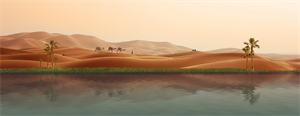
Oasis
A desert may be hot, such as the Thar, or cold, such as Ladakh. The Thar Desert is the seventeenth-largest desert in the world and the ninth largest hot subtropical desert. It is also called as 'Great Indian Desert'. It is located partly in Rajasthan state in northwestern India and partly in the provinces of Punjab and Sindh (Sind) in eastern Pakistan. Ladakh is a cold desert on the eastern side of Jammu and Kashmir, located in the Great Himalayas.
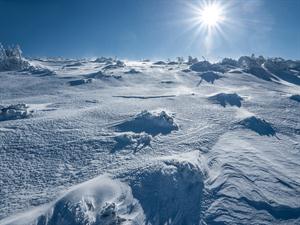
Antarctica ice desert landscape
The world's highest desert is the 'Antarctic desert,' which occupies Antarctica and covers about \(5.5\) million square miles.
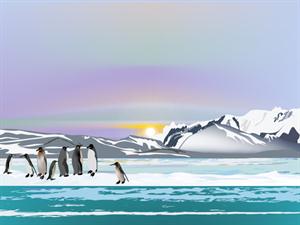
Penguins in ice desert landscape
People commonly refer to an area as a desert if it has little or no water or plants.
Though there are deserts with water resources, some of them are dry and waterless. Generally, deserts receive less than 25 centimetres (\(10\) inches) of precipitation per year on average, but some deserts receive very little rainfall. The Atacama desert is one of the driest deserts that receives only around 1.5 cm (0.06 inches) a year. As a result, water resources do not occur, and rainfall fails in these deserts. When strong winds blow, it creates sand deposits; when sand rises, it settles as hillocks.
In short, a dune is a wind or water-built hill made of dry or wet soil. The wind raises or moves sand from one location to another as it blows. When the wind stops blowing, it collects in a single area, forming hill-like structures. These are called Sand dunes which are found in deserts.
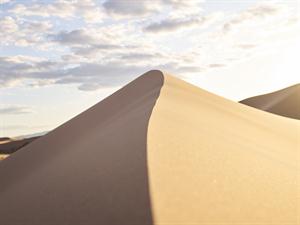
Sand dunes
One can see sand dunes in deserts, beaches, and even eroded and empty farm fields in semi-arid regions where loose sand is windblown. Only few plants can survive in such dusty, shifting sands.
Living things need water, and it is essential to most bodily functions. Water is required by all living organisms daily. For example, we need water to quench our thirst. If we do not drink water, it will result in adverse situations.
While most plants and animals need water regularly to survive, some desert plants and animals have adapted their bodies to suit the desert environment. As a result, they do not need more water for survival. For example, the structure of Cacti plants helps them to consume less water. Cactus is a succulent plant that lives in deserts or dry areas. Its system is designed to store water inside its cells, which can retain for a long time.
While most plants and animals need water regularly to survive, some desert plants and animals have adapted their bodies to suit the desert environment. As a result, they do not need more water for survival. For example, the structure of Cacti plants helps them to consume less water. Cactus is a succulent plant that lives in deserts or dry areas. Its system is designed to store water inside its cells, which can retain for a long time.
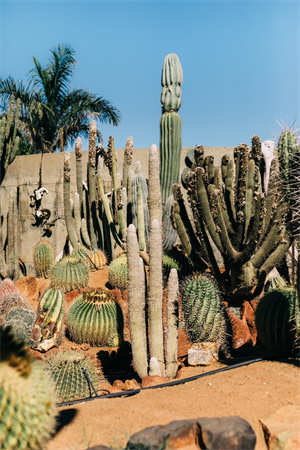
Succulents
While some desert animals prevent water leaving from its body, other animals' bodies were designed in a way to drink less water. For example, the Kangaroo rat that lives in the southwestern deserts of the United States does not drink water in its life span. A typical desert adaptation of desert animals was that it does not expose itself to hot temperature to save water in its body.
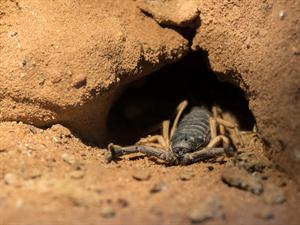
Scorpion in its burrow
Desert animals like tortoises, toads, foxes etc., use burrows to escape from the hot desert surface. 'Camel' is a less water consuming living desert being. It's the best example of a desert animal that can survive without water for many days. Since it sweats little and can consume a lot of water, it survives in the desert.
In general, human beings sweat when their bodies get exposed to hot climatic conditions. This sweating happens to keep the body cool and to maintain the body temperature. The body temperature of camels is different. Since the body of camels was designed in such a way to endure high temperature, there are fewer chances for them to sweat. So, if camels drink a lot of water at one time, they would sustain in their body for a long time. Camels are called 'ship of the desert' as it is the only mode of transportation in desert areas. People living in deserts largely depend on camels for their travel.
Desert animals like tortoises, toads, foxes etc., use burrows to escape from the hot desert surface. 'Camel' is a less water consuming living desert being. It's the best example of a desert animal that can survive without water for many days. Since it sweats little and can consume a lot of water, it survives in the desert.
In general, human beings sweat when their bodies get exposed to hot climatic conditions. This sweating happens to keep the body cool and to maintain the body temperature. The body temperature of camels is different. Since the body of camels was designed in such a way to endure high temperature, there are fewer chances for them to sweat. So, if camels drink a lot of water at one time, they would sustain in their body for a long time. Camels are called 'ship of the desert' as it is the only mode of transportation in desert areas. People living in deserts largely depend on camels for their travel.

Camel-The ship of the desert
As mentioned earlier, some animals do not drink water during their lifespan, like the Kangaroo rat, which lives in the south-western deserts of the U.S. They do not come out during the day time to escape from the hot surface temperature. These animals, though, get their water content from the foods they eat. These animals live in burrows and do not come out during the daytime to safeguard from the hot temperature and to save water from its body.
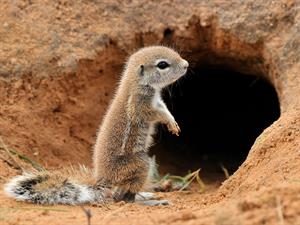
Squirrel’s burrow
They kill and eat other desert animals for their survival, and the water content is supplied through the meat of the hunted ones.
While some animals hunt and eat others animals, others in the deserts depend on plants for their survival. So, they eat plants and get water content from the juice of the plants.
On the other hand, desert plants also grow well in deserts, making themselves suitable to grow under the harsh conditions of the deserts. Among them, Cacti are the more common variety. Apart from plants, some desert trees also grow well under the harsh conditions of deserts.
As mentioned earlier, Cacti plants can be the best example in terms of adapting themselves to the climatic region of the deserts. Their thick, fleshy structure help in storing water inside its body.
The surprising fact about Cactus plants is that they could develop temporary roots in two hours to absorb water when it rains, and the roots get dried up once the rain stops. The roots of Cactus plants are shallow and widespread ones that spread out in several meters, which helps in collecting water from the wet soil.
- Pancake Prickly Pear Cactus
- Barrel Cactus
- Saguaro Cactus
- Lace or Hedgehog Cactus
- Organ Pipe Cactus
- Brittlebush
- Creosote Bush
- Desert Ironwood Plant
Deserts are vital to the planet for a variety of reasons. It is home to approximately one-sixth of the world's population. Deserts play a crucial role in the formation of essential minerals. Deserts produce useful minerals such as gypsum, borates, nitrates, potassium, feldspar, kaolin, and other salts as a result of evaporation. Feldspar, phosphorite, gypsum, and kaolin can be used to produce a variety of fertilisers, cement etc.
Some plants that have adapted to the harsh climatic conditions of deserts store chemicals. This form of chemical extraction could be used to treat human diseases.
Some plants that have adapted to the harsh climatic conditions of deserts store chemicals. This form of chemical extraction could be used to treat human diseases.
Wind and solar energy are also generated in deserts. Deserts have around half of the world's copper. The extraction of gold and diamonds is mainly dependent on deserts. Deserts contain around \(75%\) of the world's oil.
Apart from the uses listed above, the desert has a variety of other benefits. Therefore, deserts are not as useless as many people believe, but they are as beneficial to the planet as forests and oceans. Therefore, deserts cannot be rejected as useless just because they are dry and hot.
